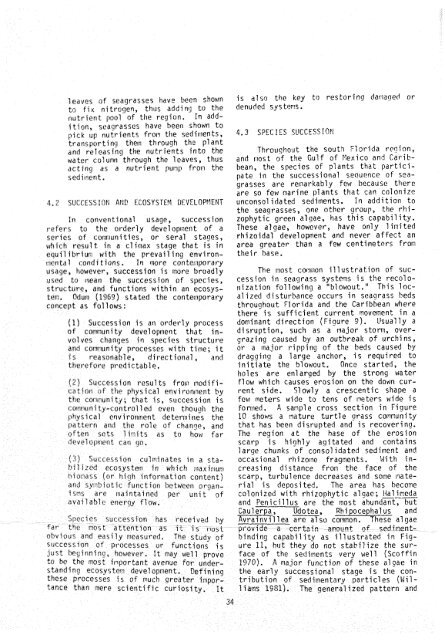The Ecology of the Seagrasses of South Florida - USGS National ...
The Ecology of the Seagrasses of South Florida - USGS National ...
The Ecology of the Seagrasses of South Florida - USGS National ...
Create successful ePaper yourself
Turn your PDF publications into a flip-book with our unique Google optimized e-Paper software.
leaves oF seagrasses hav2 been shown is also <strong>the</strong> key tcl restoring dananed or<br />
to Fig nitrogen, thus adding to <strong>the</strong> denuded syster~s.<br />
r~utrrient. pool <strong>of</strong> <strong>the</strong> region. In addjtjonx<br />
5cagrassrs have beer1 shown to<br />
pick ilp qut.ricnts from <strong>the</strong> sedirilents, 4.3 SPECIES Sl+'CCESSIOpI<br />
transporting <strong>the</strong>ir1 throuqh th2 plant<br />
and relcaslng <strong>the</strong> nutrients into <strong>the</strong> Thro~rqhout <strong>the</strong> sout? <strong>Florida</strong> rcoion,<br />
water cirluinri through <strong>the</strong> leaves, thus and nost <strong>of</strong> <strong>the</strong> Gulf <strong>of</strong> Eexico and Caribdcthng<br />
as a nutrient puvp fror? <strong>the</strong> bean, <strong>the</strong> species <strong>of</strong> plants that particiseciis?er~l<br />
pate in <strong>the</strong> successional se~ucnce <strong>of</strong> seagrasses<br />
are remarkably few because thtirr<br />
are so few marine plants that can colonize<br />
4.2 SIICCESSICIEJ ANE! ECOSYSTEM OEVELOPMENT unconsol ida tcd sedirnents. In addition to<br />
<strong>the</strong> seaqrasses, one o<strong>the</strong>r group, <strong>the</strong> rhi-<br />
In eonventlonal usage, succession zophytic green algae, has this capability.<br />
r-csfers to <strong>the</strong> orderly development <strong>of</strong> a <strong>The</strong>se algae, however, have only linited<br />
scrics <strong>of</strong> c~~n.j~jni ties, or sera1 stages, rhi zoidal development and never affect an<br />
which rc%ulb; Jn a clitaax stage that is in area greater than a few centimeter5 from<br />
eqrrli 1 ltlriur: with <strong>the</strong> prevail tny environ- <strong>the</strong>ir haw.<br />
rwrt tn f cond i t Jtrns . f rl wre con tei?porarSy<br />
u%i;nge, trowever, nuccesslion is more brtladl y <strong>The</strong> rlost cor71;ron illustration <strong>of</strong> sucxtsed<br />
to i*oelan <strong>the</strong> succession <strong>of</strong> ?;prcir;s, cession In scagrass systc~s is <strong>the</strong> rccolo-<br />
$trudture, and functfons within an ecosys- nization fallowing a "blowout." This loc-<br />
Leu.:, Odurtr (19654) stated contemporary al i zcd di sturhance occurs in seagrass heds<br />
concept 4% follows :<br />
througlrout <strong>Florida</strong> and <strong>the</strong> Caribbean where<br />
<strong>the</strong>re is sufficient current movement in a<br />
1) Suecessi<strong>of</strong>~ $5 an orderly process domillant direction (Figure 9). Usually a<br />
<strong>of</strong> cry$t~t~*rtrn.i t-y devclogment; thdt in- dl srugtfon, such as a rlajor stortn, overvrrlvcr<br />
changes in species Structure grazing caused by an outbreak <strong>of</strong> urchins,<br />
and casr:nrvun!tt;y prcrccsscs with tittle; it or a trldjor rjpping <strong>of</strong> <strong>the</strong> beds caused by<br />
$5 rcaronirhle, directtonal, and drdgyirlg a large anchor, is required to<br />
truere tore [nredicldlrl e,<br />
initiate th~? blo~out, Once started, <strong>the</strong><br />
holes are enlarged by <strong>the</strong> strong water<br />
(2) Sucecss?lon results fro111 plodiff- flow which causes erosion on <strong>the</strong> dovin cur-<br />
(:dtS<strong>of</strong>\ <strong>of</strong> tile ~3haysicill envir~~~q~ylt b~ rent side. Slowly a crescentic shape a<br />
<strong>the</strong> corat8urri ti; that is, sajccession .is Few nleters bride to tens <strong>of</strong> peters wide is<br />
cots!tioity+controI ICE^ CV~II th~tugit <strong>the</strong> Forrned. A saapl c cross section in Figure<br />
b~hy..;icxnf cnvirari~rienl deterinitles <strong>the</strong> 10 shows a mature turt? e grass corlnuni ty<br />
~t~clttt%rn and <strong>the</strong> r01~ OF chan~p, and that has been d3srupted and is recoverin$.<br />
t~rten sets lr";..rEts ds to haw far <strong>The</strong> region at <strong>the</strong> hasc <strong>of</strong> <strong>the</strong> erosion<br />
dlzvcl ikpriaent cdri qn, scarp is highly agitated and contains<br />
large chunks <strong>of</strong> consol idated sediment and<br />
63) Ssar,ee!ssinrl cuf rriiitates irr a st*- occasional rhirorile frag~ents, CIi th inbll<br />
cctlsystart in which ;rraxicturrt creasing distance from <strong>the</strong> face <strong>of</strong> <strong>the</strong><br />
I%~PJI\~SS<br />
%or hfqh dnfonaiation c~ntcnt) scarp, turbulence decreases and sorne {?atedfld<br />
~~:thfotir: ~WIIC~~D~) bct~~en or.gan- rial is deposited. <strong>The</strong> area has hecome<br />
4 sF1s are ~r~ixintlsinftd per irr~it <strong>of</strong> colonizetl with rhizophytic algae; Hal imda<br />
avilll ablx? etrerlry Flow,<br />
and Penicillus are <strong>the</strong> most abundant, but<br />
, -tihatea, -- Rhipocephalus and<br />
Species ruccessfon has received by 1 lea are also comon. <strong>The</strong>se algae<br />
far tqe R0St atreririon as it is r-tusi pi-avid+ a certain a~ount f sedirqent-<br />
~bviuus and easily mcasused, <strong>The</strong> study <strong>of</strong> binding capability as illustrated iq Figsracce%sion<br />
af pt-acesses or functions is ure II, htrt <strong>the</strong>y do nut stabilize <strong>the</strong> surjust:<br />
ta@$jnnln?, however, Xt: nlay well 1 prove face <strong>of</strong> <strong>the</strong> sedirqents very well (Sc<strong>of</strong>fin<br />
fl(J5t i!?partant @venire for undey- 1970). A rslajor function <strong>of</strong> <strong>the</strong>se a1 gae in<br />
standing ecosysle;ln development. Defining <strong>the</strong> early successional stage is <strong>the</strong> con-<br />
PPQCESS@S is OF much greater impor- tri bu tian <strong>of</strong> sedimentary particles (Hi 1 -<br />
ta~c@ than raerc scietltific curiosfry. It liatns 1981)- <strong>The</strong> generalized pattern and<br />
34

















